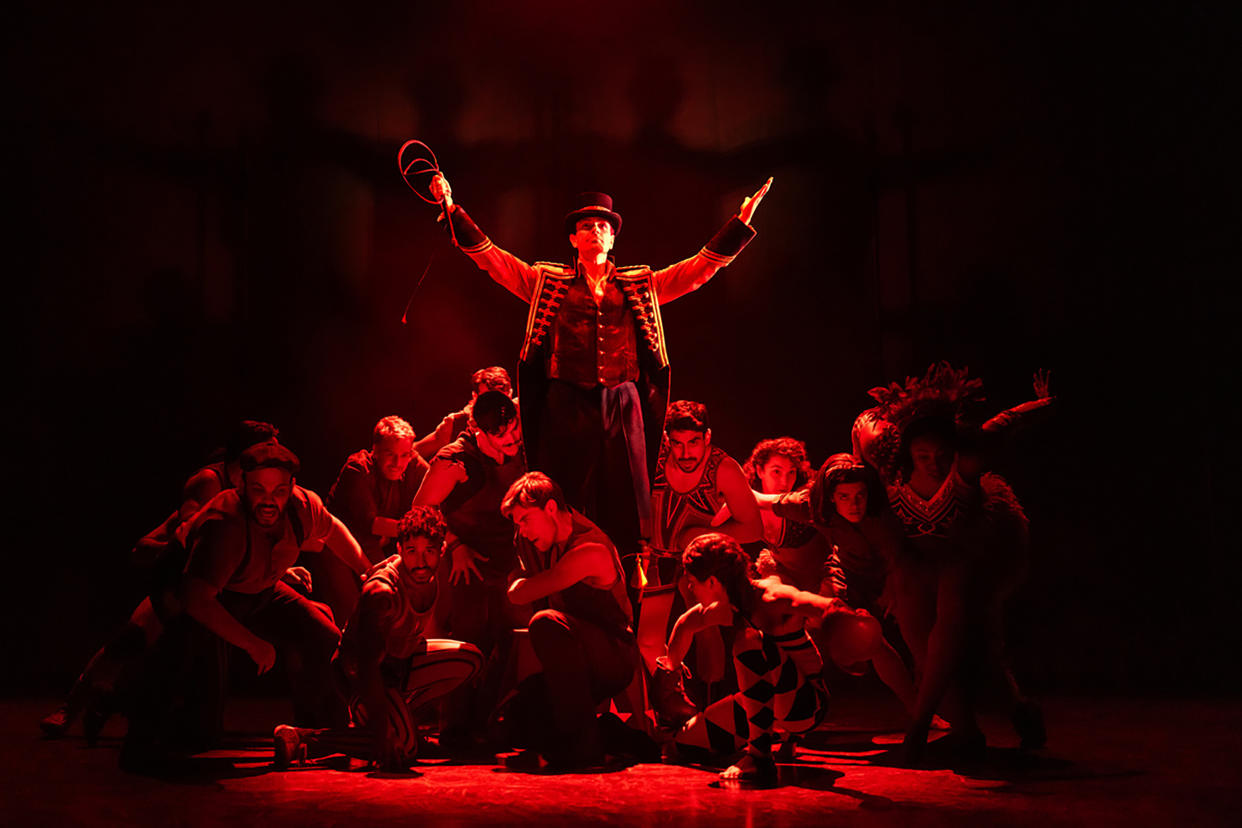Review: 'Water for Elephants' is one of the most authentic circus-themed shows to make it to Broadway

- Oops!Something went wrong.Please try again later.
“Water for Elephants,” the new musical based on the 2006 Sara Gruen novel and the 2011 movie with Reese Witherspoon, has one of the more remarkable ensembles ever seen on Broadway. I’ve seen a hundred shows where actors try to do tricks, or forge a circus milieu; usually, it fails because cliches are irresistible and while there are obvious similarities between the two disciplines, they require distinct skill sets. But this hugely talented crew sings, dances and are laudably believable as acrobats, aerialists and roustabouts from the tawdry touring circus culture of America in the early 20th century, the setting of a sentimental sawdust story wherein an elephant named Rosie busts her trunk through a love triangle.
Not everyone on the stage can fly to the rafters, of course, but it’s the seamless integration of what’s really a compartmentalized ensemble that reveals the fusing visual talents of the director, Jessica Stone. Here, by blending the worlds of Broadway and the not-so-big top, a tent always in danger of collapse, Stone captures a milieu that has slipped away from many hands. And I say this as a circus geek who saw every Ringling and Cirque show for decades and who regards circus folk with awe. Their lot is well represented here. Don’t let anyone tell you otherwise.
“Water for Elephants” also has a variety of kinetic puppets (by Ray Wetmore, J.R. Goodman and Camille Labarre) that knocked me out. They’re collectively indicative of just how far puppeteering has come on Broadway and they’re uncommonly distinctive because of how well they are integrated into the whole. All have an emotional texture, especially Rosie, the all-important pachyderm.
Stone often reveals these puppets only in part: a leg here, a trunk there, a neck ’round the corner. And thus she evokes a world not of animals performing but of animal lives unseen. “Water For Elephants” never feels like you are watching “The Lion King.” But the animals in this story, cruelly treated by many of the humans who own them, are the moral conscience of the proceedings. Thanks to Stone, it is as if they are trying to find their way into the chaotic human narrative within which they are collateral damage.
That sentimental story, told mostly through flashback via the fading memories of an old man, Jacob Jankowski (Gregg Edelman), is of a just-trained vet who runs off with a struggling circus. Young Jacob (Grant Gustin) becomes involved with Marlena (Isabelle McCalla), inconveniently married to August (Paul Nolan), the nasty owner of a struggling operation desperate for new tricks. The needed novelty arrives when August purchases Rosie from a defunct operation. Jacob and Marlena bond over her training and protection as they all try to save their circus, even though Rick Elice’s book makes clear that it was the locus of such exploitation as to not to be worth saving.
The show strikes a balance between affection for circus culture and moral indignation, especially at its historical abuse of animals. That’s no small feat given all of the entrenched bitterness that surrounds this topic.
The score is collectively penned by the Pigpen Theatre Co., a regional collective that has worked in Pittsburgh, Chicago and elsewhere, and its fine for what it tries to do here. In the best moments, you’re put in mind of the late, great composer Roger Miller. But the overall impact of this music operates more like a dramatic soundscape, PigPen’s longtime strength, than a collection of individually arresting songs for the theater. Still, that’s hardly at odds with this conception.
The performances aren’t especially subtle but then the characterizations — the cruel ringmaster and his trapped wife, the caring young vet — always were broad in conception from the novel through the film. There’s also a bunch of moving character work from Joe De Paul as a trapped clown as well as Stan Brown (playing a longtime veteran of the rails). Nolan is an effective villain, McCalla is empathetic and Gustin is a very credible moral hero. I’m not convinced we needed quite so much of the gruff outer frame, which both meanders and chops up the action at times, but that’s not a major quibble. Not when the ensemble takes the stage.
Stone shares credit with Shana Carroll, “circus director” and co-choreographer with Jesse Robb, for the show. I don’t know who did precisely what, but the result is one of the most authentic circus-themed shows to make it to Broadway. There’s almost none of the sparkly smiles found in “Pippin” or “Barnum,” but the piece is a richer account of why many Americans fell in love with a world constantly in motion and filled with equal measures of pain and joy.

